 1922 - 1922 -
-
| Name |
Ronald Roy Hickey |
| Title |
Captain |
| Nickname |
Ron |
| Born |
12 Oct 1922 |
Gladstone, Qld  |
| Gender |
Male |
| Education |
1930 |
Kilcoy  |
| Went to school |
| Enlistment |
1942 |
Monto Qld Aust  [1] [1] |
| Enlisted in the RAAF. (Volunteer) |
- This is Ron Hickey talking about his enlistment and early training ...
"Well, my air force time starts with the fact that my elder brother Dudley joined the air force in late 1940 and was accepted into the air force and started his training against my advice to him that it would be wise not to go to war. Then in 1941, the RAAF recruiting train came to Monto and was parked in the railway yard, and they opened up for business with several men, in our local Town Hall. So I decided I would like to join the air force, and with the agreement of mum and dad, dad accompanied me up to the town Hall where I volunteered. I passed several general tests and was selected for the air force but would later go through more specific air force tests. They gave me a lot of books and said go home and study various subjects and we probably won't want to see you until next year. So that was in 1941. I was called up in 1942 and went to Brisbane, where I went through medical tests visual tests and a complete check of my physical well-being. I passed all of these and was then inducted into the air force. But I still had to go home and wait seven months before I was called up during which time I tried to improve my educational standard. I hired a school teacher, whom I visited a couple of times a week and I did some very heavy study, because I hadn't gone past scholarship. Anyway in 1942, I was called up and went to Number 3 Air Force Training School and was issued with my first uniforms. Over the next three months I did all sorts of training. Most of the training was done in the classroom, learning a lot of different subjects; rough Astro navigation; electrics; algebra, which I'd never done and had no understanding of; and one or two other subjects including the structure of the air force. We really worked hard over those three months. We also learnt about the various ranks, the way you had to behave, how to handle a rifle and a machine gun and many parades, where we did the usual marching backwards and forwards. It was quite an interesting life. We actually lived in tents beside our parade ground, but all the studies were done in rather large huts, corrugated iron walls and ceilings and roof, which were pretty hot in the summer.
I passed all subjects there with good marks, and then passed an assessment reaching a standard that enabled me to go on to learn to be a pilot which is what I wanted to be. I was in number 27 course. We were posted to Nyandra in New South Wales down near Wagga, which was a base for further training and learning to fly on Tiger moth biplanes. I think we were there for about six months, and on completion of that, I got my wings and we were then posted to Bundaberg. That was for further flying training now on twin engined aircraft and all that went with that. But unfortunately, when we got there, they didn't have sufficient aircraft, and we did a months guard duty, waiting to commence our flying, and that was 4 hours on duty, and then eight hours off which we did carrying a rifle in the middle of the night. My friend Stan Hinch had a small motorbike and we used to go into Bundaberg on our time off and visit uncle Roy and aunty Aile and enjoy a cafe meal to get away from the other. And you wouldn't believe this but we could have a mixed grill for the price of two and sixpence, and we did that fairly often. But the thing we enjoyed most was the time resting at Uncle Roy's place." I asked dad what uncle Roy was doing in Bundaberg? He went on "Uncle Roy was in the air force too at that stage, and he was a radio operator, Morse code. He would have been in Brisbane some of that time doing his training. But he was stationed in Bundaberg, because the air force was on an active role at Bundaburg with the Avro Ansons we were to train on being used as the coastal patrol aircraft operating up and down the Queensland coast looking for German activity or Japanese submarines, and as a result, he became a radio operator for the air force based in Bundaberg. And uncle Roy had two daughters and aunty Aile who was a lovely lady. They were very relaxed beautiful people. He was one of those people, who was able to draw or sketch or paint without any training and play any music at all without ever having trained as long as he had heard it sometime. In other words, he played by ear. And the time at Bundaberg was a pressure time because it was obvious what we were training for and we went through various instructors all sorts of flying, daylight and at night, gunnery proctice, a range just north of Bundaberg at which we stood in a turret down towards the tail with a Lewis Machine stuck out through an opening in a perspex dome with a trainee pilot also flying the aircraft who you swapped with. And you stood there and went through your firing practice and nearly everybody got sick so much so that it was hard not to bring up and if you shot it out through that opening in the dome the slip stream brought it back. But they were interesting days and flying was a delight. We covered country flights that took us out over Fraser Island and down as far as Pomona and out to Monto where mum and dad we and it gave me an oportunity ti beat Monto up and I really beat it up ... and to wave to mum and dad as I flew PAST their house at a lower level than the verandah with mum waving 'Get up' and from a distance out I could see Monto and I started a long descent to build up speed a friend of mine appeared off my wing tip and he stuck with me and did whatever I did so there were two of us beating up Monto. A silly thing to do but enjoyable. We're lucky we didn't kill ourselves, scared hell out of my family and nearly ruined the life of a little boy who fell off a fence as we went over and as we went towards the main street a woman came out of a corner shop there we were she dropped her parcels and ran back into the shop" I said 'she probably thought they we being attacked'. "Then I flew over Cicilia's house and eventually went on our way to Gladstone, Lady Elliott Island and back to Bundaberg. But the little masterpiece in all that was to cook my nav log and make it look right to absorb the 15 minutes that I'd beat up Monto so it wouldn't come to light in the record ... and I got top marks for my nav log. anyway that was the one opportunity, and I knew I could get away with it because dad had the executive role of aircraft spotter at Monto and that was one occasion he didn't report.
But when Des went down and joined the Air Force, that's my younger brother, and he was before the selection board they said 'and of course you've got a brother in the air force overseas and your other brother beat up Monto! And I like to think that got me a recommendation .. for fighter bombers. Though I ended up flying bombers .. by choice. Anyway that was a great time at Bundaberg and during that time I got the opportunity a couple of times of going on leave to Monto and spending time at home and in the train in my airforce uniform I was in a compartment with a lady and a very young boy and she sat as far away from me as possible and she eventually she asked me what I was and I said I was a pilot in the Australia Air Force ... and that decided her that I was obviously unreliable! and she didn't enter into any of the conversation after that. But of course the visits home were wonderful. And my parents were worrying about Dudley at that stage who was about to go overseas and anyway I remember my last flight at Bundaberg when I was selected by the ..boss .. of the airforce flying training in Bundaberg and of the Base for that matter to get my final test with him which didn't help my stress levels at all ... and on a beautiful day with him in the right seat and me uncomfortable in the left seat we took off to go through a partial cross country and various maneuvors and in an effort to be more comfortable not long after take off climbing up to 5000 feet I said to break this silence 'this aircraft doesn't climb very well does it?' being stupid because it was '0'and his private and personal aircraft and he said 'Hickey ... this aircraft flies better than you fly.' and I thought I'd done it anyway I went on to pass with a good pass and finish my time at Budaberg with the knowledge that we were destined to go over seas and after a leave and visiting Monto we were posted to Bradfield Park in Sydney which required a journey over the Harbour Bridge and a look at Sydney and what we did there was we got our various overseas equipment and some injections and then you wouldn't believe it we boarded a train back to Brisbane and boarded a ship to overseas. But when I went in to start my training at Sandgate and on my first parade a group of airman with numbers of pilots arrived on buses and out of that stepped Dudley, my elder brother. He was now an officer, a Pilot Officer, wearing his wings and was about to go overseas. At that time I stepped out of my parade went over saluted him shook his hand and said to him I'd see him in England. And of course that never happened (Dudley was killed in action before Dad arrived in England).
|
| Awards |
1944 |
Driffield Yorkshire England  [1] [1] |
| Distinguished Flying Cross (DFC) |
| WW2 |
1943 - 1945 |
UK, Europe, Middle East, India and Burma  [1] [1] |
| Halifax Heavy Bomber pilot. RAAF 466/462 squadrons Bomber Command. Completed 35 operations over enemy territory. Awarded DFC. Transferred to 96 Halifax Transport Squadron RAF. Converted to Dakotas in Egypt. Deployed to India and operated transport flights into enemy territory (Burma) |
- RAAF History.
The following are extracts from Ronald Hickey's Flying Log Book and relate to his flight training in Australia and England, his tour of duty in Bomber Command as an RAAF pilot in command of various Halifax heavy bombers in 462/466 Australian Squadrons and concluding with his transfer to 96 Transport Squadron RAF. His 35 operations over enemy territory are set out showing:
Date; Operation No.; Target; Flying time; Aircraft ID; Whether the operation was successful or not; Number of aircraft on combined mission; Aircraft Lost;
02/09/1942 Completed instruction on Tiger Moth
09/08/1942 Narrandera NSW A/C Type DH 82 Unit 8EFTS
14/10/1942 Completed course on DH 82
11/11/1942 Commenced training on Avro Anson at Bundaberg Qld Unit 8 SFTS
13/02/1943 Qualified as 1st Pilot on Avro Anson Unit 8SETS 6/04/1943 Completed Advanced Training
06/04/1943 Completed Advanced Training
22/08/1943 Selected as representative of all pilots to demonstrate competence level by flying an Oxford for the first time at Hullavington Unit ECFS (Empire Central Flying School)
04/09/1943 3AFU South Cerney
13/10/1943 3 (P)AFU Babdown Farm
31/10/1943 South Cerney
11/02/1944 Commenced training on Wellingtons 27OTU Church Broughton
28/04/1944 Assessed at Lichfield by SqL Dave Wharton as well above avverage as pilot and captain and
having good control of a sound crew and should prove very successful on operations.
04/06/1944 Commenced training on Halifax 1652CU Marston Moor
08/07/1944 Joined 466 Squadron Bomber Command Driffield on Halifax III
17/07/1944 01st op. successful. Bois-de-la-haie. 4 hours. Aircraft O. (2 A/C lost)
18/07/1944 02nd op. successful. Vaires. 5 hours. Aircraft O. (2 A/C lost)
20/07/1944 03rd op. successful. Ardouval. 4hrs 15 mins. Aircraft O. (1A/C lost)
21/07/1944 04th op. successful. Les-cettelliers.3hrs 40mins A/C O
25/07/1944 05th op. not plotted. Wanne-Eickel. 5 hrs A/C J
28/07/1944 06th op. successful. Foret-de-Nieppe. 3hrs 40mins. A/C K. (1 A/C lost)
06/08/1944 07th op. successful. Foret-de-Nieppe. 3hrs 30mins daylight A/C O
07/08/1944 08th op. successful. diverted. Caen area. 4hrs 35mins night. A/C O. (1019 aircraft 10 lost)
09/08/1944 09th op. successful. Coqueres. 4 hrs daylight. A/C O. (172 aircraft 3 lost)
11/08/1944 10th op. successful. Etaples. 3hrs 40mins daylight. A/C P (215 aircraft)
12/08/1944 11th op. successful. Brunswick. 5hrs 40mins night. A/C O (400 aircraft 27 lost)
15/08/1944 12th op. successful. Eindhoven. 3hrs 50mins day. A/C Z (1000 aircraft 3 lost)
16/08/1944 13th op. successful. Kiel. 5hrs night. A/C O. (348 aircraft 5 lost)
18/08/1944 14th op. successful. Sterkrade. 4hrs 35mins night. A/C O (234 aircraft 2 lost)
Formed Squadron 462 Crew No.9
25/08/1944 15th op. successful. Watten. 3hrs 40mins day. A/C O (161 aircraft 3 lost)
27/08/1944 16th op. successful. Homberg. 3hrs 40mins day. A/C O (243 aircraft)
31/08/1944 17th op. successful. returned with bombs. La-pourchinte. 3hrs day. A/C H
03/09/1944 18th op. successful. Soesterberg. 3hrs 35mins day. A/C N. (675 aircraft 1 lost)
09/09/1944 19th op. brought back 9000lbs. La-Havre. 4hrs 20mins day A/C N (272 aircraft)
10/09/1944 20th op. successful. La-Havre. 4hrs day A/C N (992 aircraft)
11/09/1944 21st op. successful. La-Havre 3hrs 50mins day A/C N. (218 aircraft)
12/09/1944 22nd op.successful. 5 holes. Gelsenkirche. 5hrs 5mins day A/C N (412 aircraft 7 lost)
13/09/1944 23rd op. successful. Nordstern. 5hrs 5mins day A/C N (140 aircraft 2 lost)
15/09/1944 24th op. successful. Kiel 5hrs 45mins night A/C N (490 aircraft 6 lost)
17/09/1944 25th op. successful. Boulogne. 4hrs 5mins day. A/C (762 aircraft 2 lost)
06/10/1944 26th op. successful. Sterkrade 5hrs 25mins day A/C P (320 aircraft 9 lost)
07/10/1944 27th op. successful. Kleve 4hrs 30mins day A/C U (350 aircraft 2 lost). Diverted Bungay
09/10/1944 28th op. successful. Bocum the Ruhr 5hrs 30mins night A/C W (435 aircraft 5 lost)
14/10/1944 29th op. successful. Duisburg the Ruhr 5hrs 40mins day A/C N (1013 aircraft 13 lost)
15/10/1944 30th op. successful. Wilemshaven 4hrs 30mins night A/C R (506 aircraft 4 lost)
29/10/1944 31st op. successful. 11,000 Westkapelle 3hrs 10mins day A/C Y (354 aircraft 1 lost)
30/10/1944 32nd op.successful. Cologne 6hrs 15mins A/C Y (905 aircraft)
31/10/1944 33rd op. successful. Cologne ?? Hrs A/C ?? (493 aircraft 2 lost)
02/11/1944 34th op. successful. Dusseldorf 5hrs 15mins night A/C P (992 aircraft 19 lost)
04/11/1944 35th op. successful. Bocum 5hrs 55mins night A/C Y (749 aircraft 28 lost)
Completed First Tour 35 Trips
17/01/1945 Transferred to 96 Squadron Halifax III RAF Transport Command Leconfield
Total flying time in England 431hrs 55 mins
17/04/1945 96 Squadron Middle East Transport Command. Bilbeis on Dakota aircraft
|
| Reference Number |
2 |
| Residence |
1948 - 1972 |
Brisbane, Queensland, Australia  [1] [1] |
| 138 Graceville Ave Graceville |
- Ron and Eileen (Pat) moved here from Randwick, Sydney after Ron left the RAAF and became an airline pilot wth TAA
|
| Residence |
1972 |
Caloundra City, Sunshine Coast, Qld  [1] [1] |
| Bald Knob 4552 |
| Person ID |
I2 |
Hickey, List, Bundesen, Thomsen, Jensen, Jessen |
| Last Modified |
29 Apr 2011 |
| Father |
Francis William (Frank) Hickey, b. 21 May 1893, Pialba, Qld  , d. 15 Apr 1968, St Stephen's Church Hospital, Maryborough, Qld , d. 15 Apr 1968, St Stephen's Church Hospital, Maryborough, Qld  (Age 74 years) (Age 74 years) |
| Mother |
Paulina List, b. 12 Feb 1885, Esbjerg, Skast, Ribe, Denmark  , d. 22 Mar 1964, Maryborough, Qld , d. 22 Mar 1964, Maryborough, Qld  (Age 79 years) (Age 79 years) |
| Married |
Maryborough, Qld, St Mary's Rc Chu  |
| Family ID |
F5 |
Group Sheet |
| Family |
Eileen Mary (Pat) Brooks, b. 7 Jan 1920, 93 James Street, Devonport.  , d. 18 Oct 1998, Maleny Soldiers Memorial Hospital , d. 18 Oct 1998, Maleny Soldiers Memorial Hospital  (Age 78 years) (Age 78 years) |
| Married |
1 Jan 1945 |
St Peter's, Catholic, Church, Scarborough UK  |
| Children |
|
| Photos |
 | Ronald Roy Hickey and Eileen Mary (nee Brooks)
Married New Years Day 1945 Scarborough, Yorkshire, England |
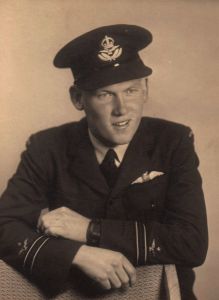 | Ronald Roy Hickey
|
| Last Modified |
18 Nov 2009 |
| Family ID |
F1 |
Group Sheet |
-
| Photos
|
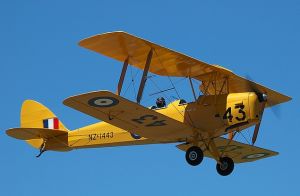 | Tiger Moth. D.H. 82
Started flying training, on Tiger Moth aircraft 9th August 1942 -14th October 1942. at Narrandera, NSW.
After successfully completing ground subjects at Initial Training School, Sandgate (3 I.T.S - No 27 course) {3 is for Qld; I. Initial; T. Training; S. School} commenced 25th April 1942 to 17th July 1942. |
 | Avro Anson
Commenced flying Avro Anson at Bunderberg (8 S.F.T.S) on 25th November 1942 - 2nd April 1943. Where Ron won his wings, with the rank of Sergeant.
On the 5th May 1943, with other RAAF aircrew, departed Australia for England, where flying training would continue. |
 | Airspeed Oxford
|
 | Wellington
|
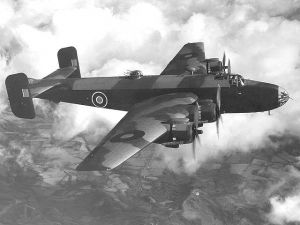 | Halifax mk 3
|
 | Dakota
|
 | T.A.A. DC-3
|
 | T.A.A. Lodestar
|
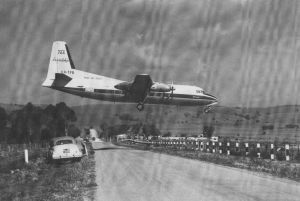 | T.A.A. Friendship
|
 | DC-6
|
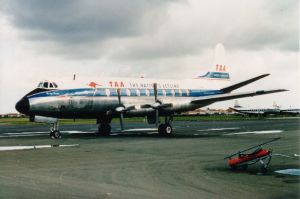 | T.A.A. Viscount
|
 | T.A.A. Lockheed L-188
|
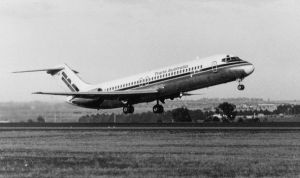 | DC-9
|
 | T.A.A. 727
|
 | Boeing 727 200
|
 | Flight Officers in England
Ron is in the second last row |
 | Captain R R Hickey
|
 | Crew
Just after Ron Hickey went onto Halifaxes.
From Left.
Morrie Draper, Hugh McClelland, Jock Cochran, Bill Woods, Lennie Rowe, Ron, and Lofty Duschene. |
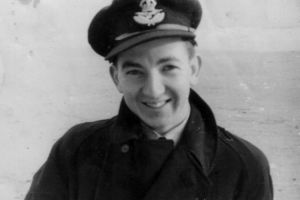 | Jock Cochran
Navigator |
 | Ron Hickey
|
 | Ron with Crew
|
 | Ron, Crew and Plane
|
 | Crew of Ron Hickey
No order to names
Morrie Draper, Hugh McClelland, Jock Cochran, Bill Woods, Lennie Rowe, Ron, and Lofty Duschene. |
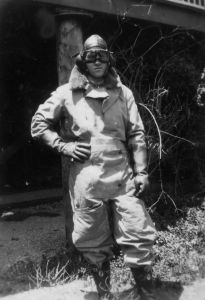 | Ron in flight gear
|
 | Ron in the cockpit
|
 | Ron and crew in Port Morsby, New Guinea.
|
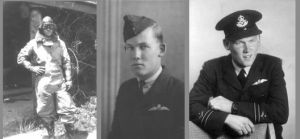 | Ronald Roy Hickey
|
 | Engines of the Halifax aircraft
|
 | Dick Meyes
Pilot.
Dick went through27 Air Crew Course at Sandgate with Ron Hickey - 1942.
|
 | Flight controls of the Halifax.
|
 | Hotel Metropole, East Sussex.
This where Ron was sent for a break after arriving in Glasgow Scotland aboard the Queen Mary, in 1943. |
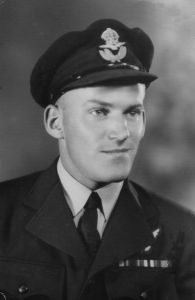 | Lenny Rowe
Radio Opperator |
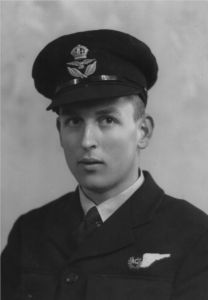 | Hugh McClelland
Mid Upper Gunner |
-
|
|